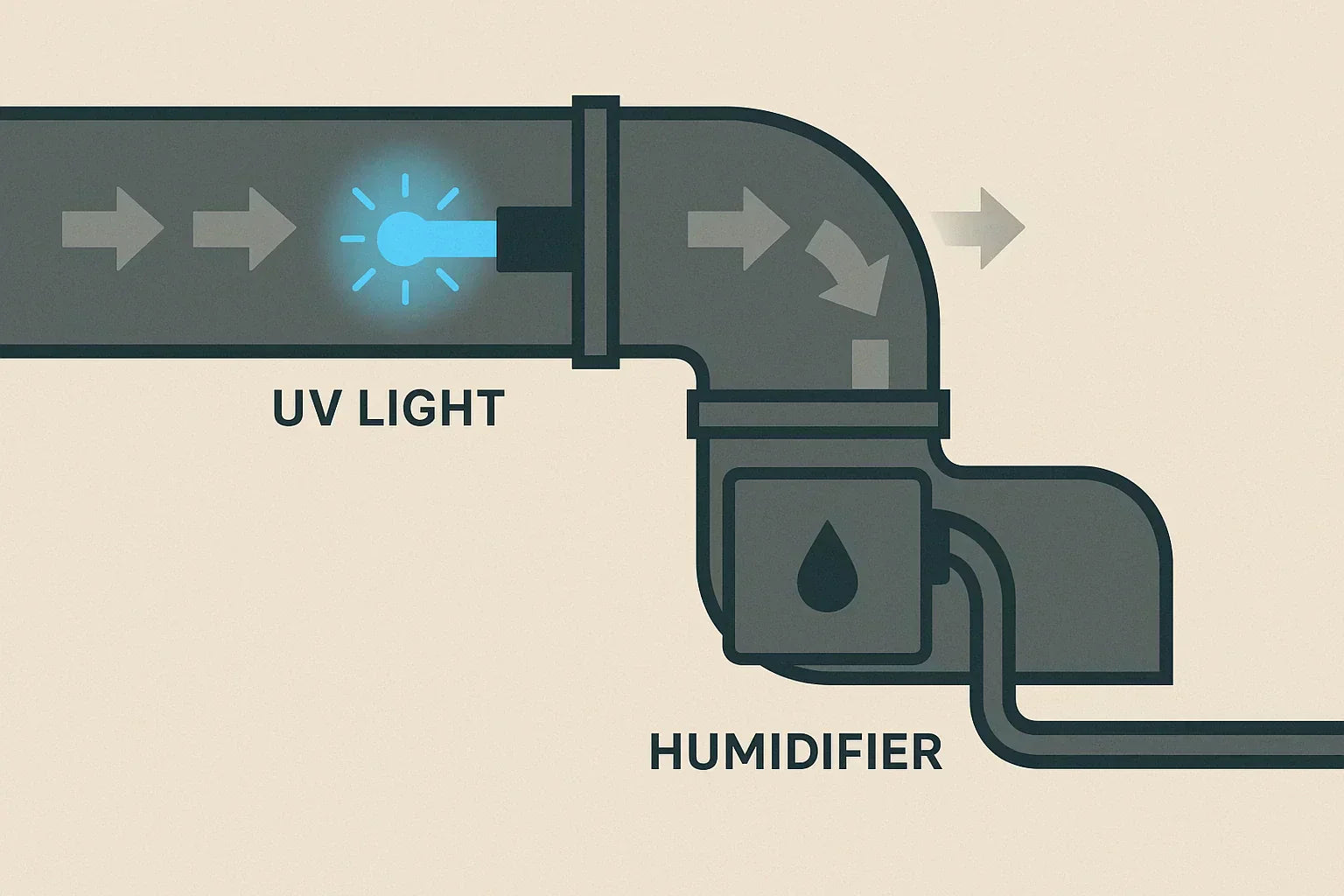When most people think about their central AC, they focus on cooling power and energy efficiency. But comfort isn’t just about temperature — it’s also about what’s in the air you breathe. If you’re dealing with allergies, musty smells, or dry indoor air, your central AC system can do more than keep you cool. With the right add-ons, it can help clean, disinfect, and balance your home’s air quality year-round.
In this guide, we’ll break down the three most common upgrades — advanced filters, UV lights, and humidifiers — so you can choose the right combination for your home.
Why Air Quality Add-Ons Matter
Your indoor air quality (IAQ) plays a major role in your health and comfort. The EPA notes that indoor air can be two to five times more polluted than outdoor air, especially in tightly sealed homes. Dust, pet dander, pollen, mold spores, and even airborne bacteria can circulate through your ducts, aggravating allergies and respiratory issues.
By integrating the right IAQ solutions into your central AC system, you can remove particulates, neutralize microbes, and maintain healthy humidity levels — without adding bulky portable devices to every room.
Filters – Your First Line of Defense
If your AC system is the lungs of your home, the filter is its immune system. It traps dust, debris, and allergens before they enter your living space.
MERV Ratings and What They Mean
Filters are rated using the MERV scale (Minimum Efficiency Reporting Value) from 1–20. Lower ratings catch larger particles (like dust and lint), while higher ratings can filter out bacteria and smoke particles.
The EPA’s guide to air cleaners and air filters explains that most residential systems work best with MERV 8–13 — high enough to capture allergens without restricting airflow.
Types of Filters
-
Fiberglass: Low-cost, basic dust protection.
-
Pleated: Higher MERV ratings, better for allergies.
-
HEPA: Hospital-grade filtration but requires compatible equipment.
Pro Tip: An overly restrictive filter can strain your blower motor. Always check your AC’s specifications before upgrading.
When to Upgrade Your Filter
If you notice dust buildup around vents, increased allergy symptoms, or odors in your home, your filter may not be performing well.
For deeper technical guidance, ASHRAE outlines how to match filtration to your home’s needs without compromising system efficiency.
UV Lights – Tackling Bacteria, Mold, and Viruses
While filters capture particulates, UV lights go after microorganisms.
How UV-C Works in HVAC Systems
Ultraviolet-C (UV-C) light damages the DNA of bacteria, mold spores, and viruses, preventing them from reproducing. These lights are typically installed either:
-
Over the evaporator coil (to prevent mold growth)
-
Inside the supply ducts (to treat passing air)
The U.S. Environmental Protection Agency (EPA) notes that UV-C light can help reduce certain airborne contaminants when properly installed and maintained as part of an HVAC system.
Limitations of UV Lights
-
They don’t filter dust or allergens — pair them with a quality filter.
-
Bulbs typically need replacement every 12–24 months.
-
Effectiveness depends on exposure time and placement.
If you have recurring mold issues in your AC, a coil-mounted UV light can save you hundreds in cleaning costs over time.
Humidifiers – Balancing Moisture for Comfort
In dry climates — or during winter heating season — your indoor humidity can drop below 30%, leading to dry skin, cracked wood floors, and static shocks.
Whole-Home vs. Portable Units
-
Whole-home humidifiers (bypass, fan-powered, or steam) connect directly to your ductwork, adding moisture to conditioned air before it’s distributed.
-
Portable humidifiers treat one room at a time but require frequent refilling.
ScienceDirect explains that maintaining indoor humidity between 30% and 50% helps optimize comfort while reducing the risk of mold and other moisture-related issues.
Benefits of Proper Humidity
-
Reduces respiratory irritation
-
Protects wood furniture and flooring
-
Helps your body feel warmer in winter, lowering heating costs
Choosing the Right Combination for Your Home
No single add-on works for every household. Consider:
-
Climate: Dry regions benefit from humidifiers; humid regions may focus on filtration and UV lights.
-
Health concerns: Allergy sufferers benefit from high-MERV filters and possibly UV disinfection.
-
Budget: Filters are the most affordable upgrade; UV lights and humidifiers require a larger investment.
If you’re already exploring new AC options, our Top 10 Central AC Units Compared guide includes models with built-in IAQ features.
Maintenance and Longevity
IAQ upgrades only work if they’re maintained.
-
Filters: Replace every 1–3 months, depending on MERV rating and usage.
-
UV lights: Replace bulbs on schedule, even if they’re still glowing.
-
Humidifiers: Clean water panels annually to prevent mineral buildup.
The EPA’s IAQ maintenance tips cover how to keep these systems performing year-round.
Alex’s Final Thoughts
In my years as an HVAC tech, I’ve seen the difference IAQ upgrades make — not just in cleaner air, but in fewer breakdowns and happier homeowners. A well-chosen filter, a strategically placed UV light, and a properly tuned humidifier can turn your central AC into a comfort powerhouse.
If you’re ready to explore your options, talk to a qualified HVAC professional. And if you want to know whether you can mix and match equipment, check out Can You Install a Central AC Without Replacing the Furnace? — it’s a smart read before your next upgrade.
Alex Lane
Your Home Comfort Advocate







